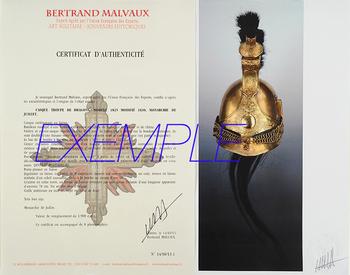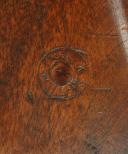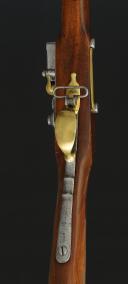
FUSIL DE DRAGONS POUVANT ÊTRE ATTRIBUÉ AUX DRAGONS DE LA GARDE IMPÉRIALE, modèle An IX, de La Manufacture de Versailles, Premier Empire.
Sold out
DRAGOON MUSKET POTENTIALLY ATTRIBUTED TO THE IMPERIAL GUARD DRAGOONS, An IX model, from La Manufacture de Versailles, First Empire.
Wood stock, cheekpiece stamped with the "D" of Deschaseaux, and a "N°1" under an unidentified "B", barely legible acceptance stamp "EF ...", with cock stamp with the inscription "PLD" (state property). Five-sided short thunder barrel, stamped "DT" (Dombret Martial, master gunner/reviewer from 1811 to 1814), "D" (Deschaseaux Jean-Baptiste, 1st controller from 1806 to 1818), and "J" (Jacquesson, inspector from 1810 to 1811), breech tang marked "Mle An 9", length 1.03 m, length with breech tang 1.08 m, caliber 17.5 mm. Flintlock mechanism, stamped "G" (Germain Augustin, reviewer from 1812 to 1818) and signed "Mre Imple De Versailles" (Manufactured from 1807 to 1814). All fittings stamped with "D" of Deschaseaux. Brass muzzle cap secured by a steel spring. Steel swivel attached by a spring placed in the center of the two bands and resting on the inner band. Brass thumb plate and counterplate. Steel butt plate. Steel ramrod.
All the stamps on this weapon indicate it dates back to 1812.
Total length of the musket 1.425 meters.
France.
First Empire, around 1812.
Superb state of preservation, a crack in the wood between the breech tang and the top of the back of the lockplate.
ATTRIBUTION TO THE IMPERIAL GUARD:
While the infantry, the Horse Grenadiers, Horse Chasseurs, Mamelukes, and Dutch Grenadiers of the Imperial Guard were equipped with specific weapons, the Dragoons, known as the “Empress's Dragoons,” were issued the An IX dragoon musket, although in the regulations nothing distinguishes the dragoon musket of the line dragoons from those of the Imperial Guard.
However, this specimen features a pronounced beak-like brass muzzle cap specific to the Imperial Guard dragoon musket. This perfectly stamped brass muzzle cap, following the other fittings stamped with the "D" of Deschaseaux, allows for the attribution to the Empress's Dragoons regiment.
PAYMENT INFORMATION:
Firearms cannot be paid for via Paypal. This company refuses to trade any type of weapons, including collectible firearms that are freely circulated and held. Therefore, only checks, remote credit card payments (VPC), and IBAN transfers are accepted.
Google Ranking Service Warning:
This firearm is an old collectible weapon that cannot be used, as it is inactive, and current cartridges cannot be used with this non-functioning firearm. The law of March 6, 2012, classifies weapons into 4 categories and regulates their acquisition and possession. Proper classification is therefore crucial. Decree No. 2013-700 of July 30, 2013, specifies the list of weapons falling under each category. The weapon presented here is in category D2, freely held, and can be purchased without any restrictions, as it is inactive.
PAYMENT INFORMATION:
Firearms cannot be paid for via Paypal. This company refuses to trade any type of weapons, including collectible firearms that are freely circulated and held. Therefore, only checks, remote credit card payments (VPC), and IBAN transfers are accepted.
Google Ranking Service Warning:
This firearm is an old collectible weapon that cannot be used, as it is inactive, and current cartridges cannot be used with this non-functioning firearm. The law of March 6, 2012, classifies weapons into 4 categories and regulates their acquisition and possession. Proper classification is therefore crucial. Decree No. 2013-700 of July 30, 2013, specifies the list of weapons falling under each category. The weapon presented here is in category D2, freely held, and can be purchased without any restrictions, as it is inactive.
NOTE:
THE END OF A LEGEND "PDL" - THE MARKING ON NATIONAL GUARD WEAPONS
Numerous researches have failed to find any citation that could confirm the reality of this motto "For the right." So what is it? What is the National Guard? The National Guard was created during the Revolution. It is a militia tasked with maintaining order and upholding the law in troubled times. It consists of all citizens aged 20 to 60. They are listed and classified for service, either in reserve duty or active duty. Initially, National Guards were mostly bourgeois because they were asked to equip themselves at their expense, and to be in the cavalry, one needed to have a horse. For the bourgeois, this role was a way to maintain a form of power, to set themselves apart from the population of other citizens. National Guards were spread across all municipalities. They served as "police" under the command of a superior, the mayor, and the prefect. Under the Empire, the National Guard sometimes served as a reserve army and was mobilized when needed for Napoleon's wars. After their dissolution by Charles X in 1827, the National Guard was reestablished by Louis Philippe in 1830, with a company in each municipality. Companies of infantry, artillery, cavalry, and firefighters were formed. The National Guard was reactivated to quell disturbances and maintain calm throughout France after the July Revolution. In 1831, the marking on weapons as "PDL."
In late 1830, the Minister wanted to organize the National Guards. He aimed to structure the troops and ordered the collection and inventory of weapons previously distributed during the July Revolution. A document from the archives of the city of Lyon dated August 10, 1830, attests to this. In January 1831, a ministerial circular mandated the marking of arms distributed by the Ministry of War and belonging to the state. These arms were to be stamped with the acronym "PLD" to indicate "Property Of the State," as shown in a document from January 20, 1831, from the prefecture in the Lyon archives.
This marking would be done using a stamp that would travel from village to village within each canton. The stamping would be carried out in the presence of assembled National Guards by the mayors and commanders. The stamp would remain in the possession of the canton's administrative center, allowing for future stamping. A record would be drawn up, signed by the Mayor, and sent to the prefecture.
National Guards were equipped with a variety of arms, including rifles, sabers, cartridge boxes, and other military-type equipment and uniforms, often privately made and differing slightly from standard models. These items were acquired by National Guards themselves or by municipalities. Furthermore, there were regulation weapons provided to municipalities by the Ministry of War.
Only this last category of state-owned equipment received the marking to confirm state ownership and prevent the dispersal of arms. An excerpt from the January 1831 circular details the method to be used for marking rifles. The same circular also mentions the creation, with the Interior Minister's approval, of an armament manual for the National Guards.
In 1848, following the February Revolution and the advent of the Second Republic, a decree reactivated the National Guard in March. The first page of the "Courrier de la Drome et de l'Ardèche" from October 29, 1848, No. 224, demonstrates that the same measures as in 1831 (law still in effect) were taken, including the census of National Guards and their weapons. The marking "PLD" on state-owned arms was reaffirmed. It was also noted that the conversion to percussion of National Guard arms by private gunsmiths was prohibited to avoid the proliferation of available calibers.
The "PLD" stamp:
The mark in the wood created by applying a blackened metal imprint with flames bears the letters "PDL." For a long time, these letters were interpreted as the motto "For The Right," which seems to have no basis. These documents show that it simply refers to "Property Of the State." The rooster symbol atop was reintroduced by Louis Philippe upon coming to power in 1831. This mark is found on the wood of pistols and regulation rifles used by the National Guard. These were often the model 1816 or 1822 troop pistols and frequently the model 1777 corrected An IX rifles. The War Ministry distributed antiquated arms to the National Guards, reserving the more recent 1822 models for the military. Later models included the 1822 T and Tbis versions.
Evolution of the PDL marking:
Consulting military archives revealed other variations of this state identification mark. The PDL marking is also occasionally found on edged weapons like swords or bayonets.
Wood stock, cheekpiece stamped with the "D" of Deschaseaux, and a "N°1" under an unidentified "B", barely legible acceptance stamp "EF ...", with cock stamp with the inscription "PLD" (state property). Five-sided short thunder barrel, stamped "DT" (Dombret Martial, master gunner/reviewer from 1811 to 1814), "D" (Deschaseaux Jean-Baptiste, 1st controller from 1806 to 1818), and "J" (Jacquesson, inspector from 1810 to 1811), breech tang marked "Mle An 9", length 1.03 m, length with breech tang 1.08 m, caliber 17.5 mm. Flintlock mechanism, stamped "G" (Germain Augustin, reviewer from 1812 to 1818) and signed "Mre Imple De Versailles" (Manufactured from 1807 to 1814). All fittings stamped with "D" of Deschaseaux. Brass muzzle cap secured by a steel spring. Steel swivel attached by a spring placed in the center of the two bands and resting on the inner band. Brass thumb plate and counterplate. Steel butt plate. Steel ramrod.
All the stamps on this weapon indicate it dates back to 1812.
Total length of the musket 1.425 meters.
France.
First Empire, around 1812.
Superb state of preservation, a crack in the wood between the breech tang and the top of the back of the lockplate.
ATTRIBUTION TO THE IMPERIAL GUARD:
While the infantry, the Horse Grenadiers, Horse Chasseurs, Mamelukes, and Dutch Grenadiers of the Imperial Guard were equipped with specific weapons, the Dragoons, known as the “Empress's Dragoons,” were issued the An IX dragoon musket, although in the regulations nothing distinguishes the dragoon musket of the line dragoons from those of the Imperial Guard.
However, this specimen features a pronounced beak-like brass muzzle cap specific to the Imperial Guard dragoon musket. This perfectly stamped brass muzzle cap, following the other fittings stamped with the "D" of Deschaseaux, allows for the attribution to the Empress's Dragoons regiment.
PAYMENT INFORMATION:
Firearms cannot be paid for via Paypal. This company refuses to trade any type of weapons, including collectible firearms that are freely circulated and held. Therefore, only checks, remote credit card payments (VPC), and IBAN transfers are accepted.
Google Ranking Service Warning:
This firearm is an old collectible weapon that cannot be used, as it is inactive, and current cartridges cannot be used with this non-functioning firearm. The law of March 6, 2012, classifies weapons into 4 categories and regulates their acquisition and possession. Proper classification is therefore crucial. Decree No. 2013-700 of July 30, 2013, specifies the list of weapons falling under each category. The weapon presented here is in category D2, freely held, and can be purchased without any restrictions, as it is inactive.
PAYMENT INFORMATION:
Firearms cannot be paid for via Paypal. This company refuses to trade any type of weapons, including collectible firearms that are freely circulated and held. Therefore, only checks, remote credit card payments (VPC), and IBAN transfers are accepted.
Google Ranking Service Warning:
This firearm is an old collectible weapon that cannot be used, as it is inactive, and current cartridges cannot be used with this non-functioning firearm. The law of March 6, 2012, classifies weapons into 4 categories and regulates their acquisition and possession. Proper classification is therefore crucial. Decree No. 2013-700 of July 30, 2013, specifies the list of weapons falling under each category. The weapon presented here is in category D2, freely held, and can be purchased without any restrictions, as it is inactive.
NOTE:
THE END OF A LEGEND "PDL" - THE MARKING ON NATIONAL GUARD WEAPONS
Numerous researches have failed to find any citation that could confirm the reality of this motto "For the right." So what is it? What is the National Guard? The National Guard was created during the Revolution. It is a militia tasked with maintaining order and upholding the law in troubled times. It consists of all citizens aged 20 to 60. They are listed and classified for service, either in reserve duty or active duty. Initially, National Guards were mostly bourgeois because they were asked to equip themselves at their expense, and to be in the cavalry, one needed to have a horse. For the bourgeois, this role was a way to maintain a form of power, to set themselves apart from the population of other citizens. National Guards were spread across all municipalities. They served as "police" under the command of a superior, the mayor, and the prefect. Under the Empire, the National Guard sometimes served as a reserve army and was mobilized when needed for Napoleon's wars. After their dissolution by Charles X in 1827, the National Guard was reestablished by Louis Philippe in 1830, with a company in each municipality. Companies of infantry, artillery, cavalry, and firefighters were formed. The National Guard was reactivated to quell disturbances and maintain calm throughout France after the July Revolution. In 1831, the marking on weapons as "PDL."
In late 1830, the Minister wanted to organize the National Guards. He aimed to structure the troops and ordered the collection and inventory of weapons previously distributed during the July Revolution. A document from the archives of the city of Lyon dated August 10, 1830, attests to this. In January 1831, a ministerial circular mandated the marking of arms distributed by the Ministry of War and belonging to the state. These arms were to be stamped with the acronym "PLD" to indicate "Property Of the State," as shown in a document from January 20, 1831, from the prefecture in the Lyon archives.
This marking would be done using a stamp that would travel from village to village within each canton. The stamping would be carried out in the presence of assembled National Guards by the mayors and commanders. The stamp would remain in the possession of the canton's administrative center, allowing for future stamping. A record would be drawn up, signed by the Mayor, and sent to the prefecture.
National Guards were equipped with a variety of arms, including rifles, sabers, cartridge boxes, and other military-type equipment and uniforms, often privately made and differing slightly from standard models. These items were acquired by National Guards themselves or by municipalities. Furthermore, there were regulation weapons provided to municipalities by the Ministry of War.
Only this last category of state-owned equipment received the marking to confirm state ownership and prevent the dispersal of arms. An excerpt from the January 1831 circular details the method to be used for marking rifles. The same circular also mentions the creation, with the Interior Minister's approval, of an armament manual for the National Guards.
In 1848, following the February Revolution and the advent of the Second Republic, a decree reactivated the National Guard in March. The first page of the "Courrier de la Drome et de l'Ardèche" from October 29, 1848, No. 224, demonstrates that the same measures as in 1831 (law still in effect) were taken, including the census of National Guards and their weapons. The marking "PLD" on state-owned arms was reaffirmed. It was also noted that the conversion to percussion of National Guard arms by private gunsmiths was prohibited to avoid the proliferation of available calibers.
The "PLD" stamp:
The mark in the wood created by applying a blackened metal imprint with flames bears the letters "PDL." For a long time, these letters were interpreted as the motto "For The Right," which seems to have no basis. These documents show that it simply refers to "Property Of the State." The rooster symbol atop was reintroduced by Louis Philippe upon coming to power in 1831. This mark is found on the wood of pistols and regulation rifles used by the National Guard. These were often the model 1816 or 1822 troop pistols and frequently the model 1777 corrected An IX rifles. The War Ministry distributed antiquated arms to the National Guards, reserving the more recent 1822 models for the military. Later models included the 1822 T and Tbis versions.
Evolution of the PDL marking:
Consulting military archives revealed other variations of this state identification mark. The PDL marking is also occasionally found on edged weapons like swords or bayonets.
Reference :
22880

Next update Friday, april 4th at 1:30 PM
FOR ALL PURCHASES, PAYMENT IN MULTIPLE CHECKS POSSIBLE
bertrand.malvaux@wanadoo.fr 06 07 75 74 63
An authenticity certificate of the item including the description published on the site, the period, the sale price, accompanied by one or more color photographs is automatically provided for any item priced over 130 euros. Below this price, each certificate is charged 5 euros.
Only items sold by me are subject to an authenticity certificate, I do not provide any expert reports for items sold by third parties (colleagues or collectors).









